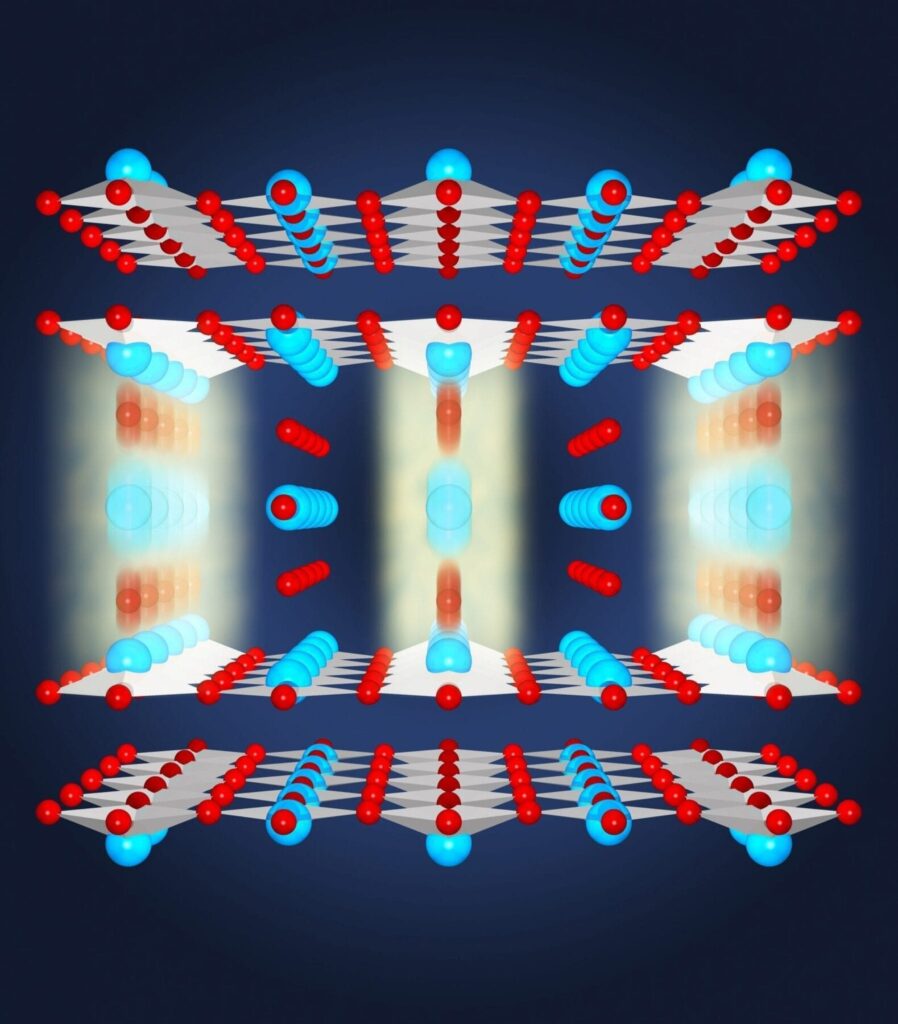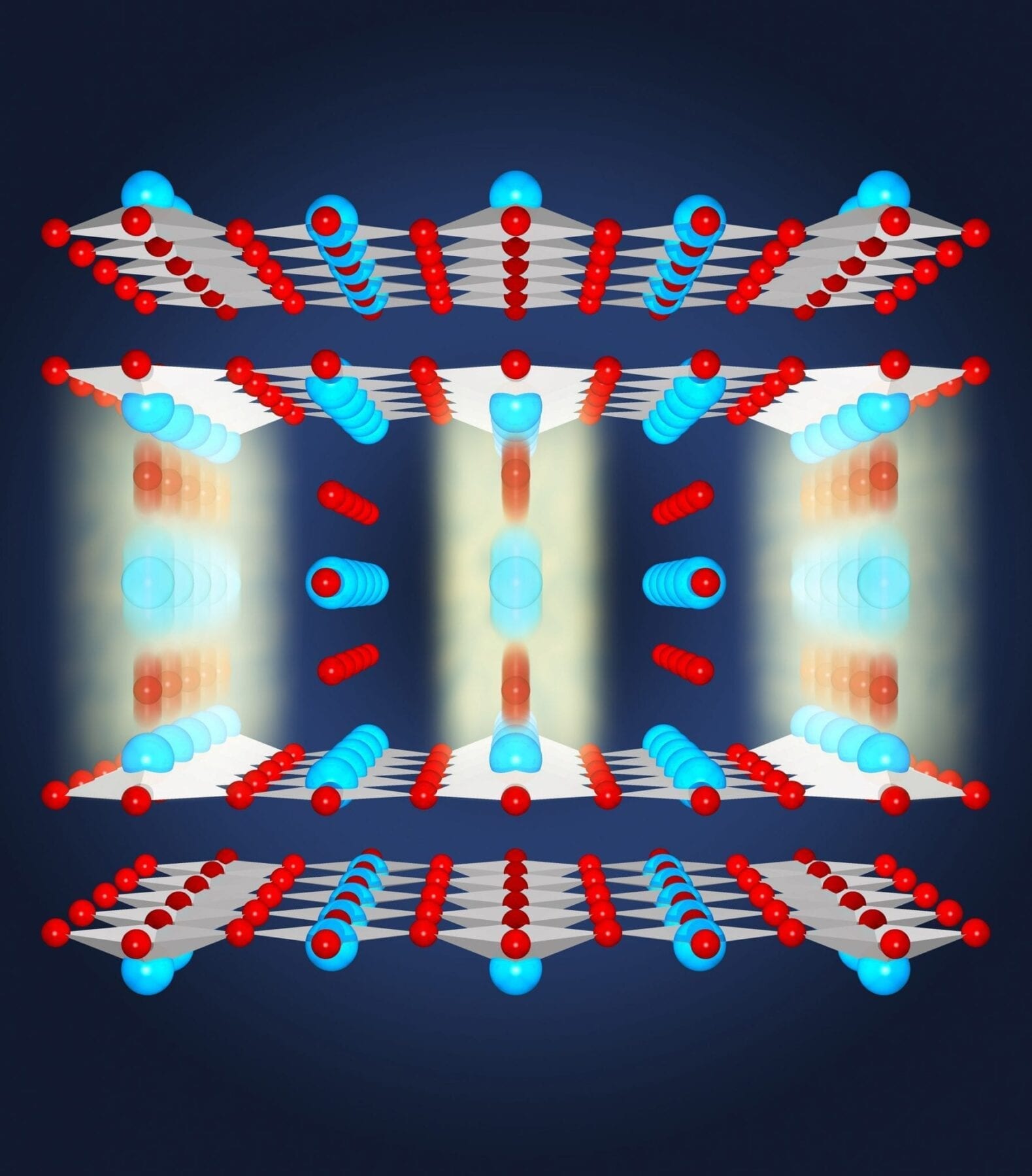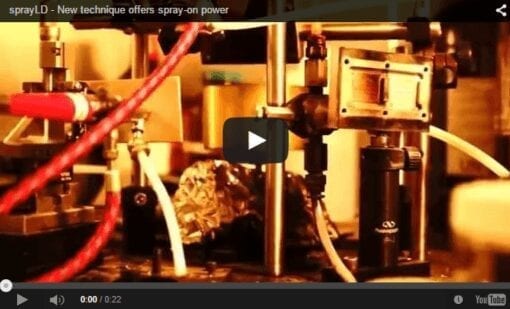
X-ray Laser Experiment Provides First Look at Changes in Atomic Structure that Support Superconductivity
An experiment at the Department of Energy’s SLAC National Accelerator Laboratory provided the first fleeting glimpse of the atomic structure of a material as it entered a state resembling room-temperature superconductivity – a long-sought phenomenon in which materials might conduct electricity with 100 percent efficiency under everyday conditions.
Researchers used a specific wavelength of laser light to rattle the atomic structure of a material called yttrium barium copper oxide, or YBCO. Then they probed the resulting changes in the structure with an X-ray laser beam from the Linac Coherent Light Source (LCLS), a DOE Office of Science User Facility.
They discovered that the initial exposure to laser light triggered specific shifts in copper and oxygen atoms that squeezed and stretched the distances between them, creating a temporary alignment that exhibited signs of superconductivity for a few trillionths of a second at well above room temperature – up to 60 degrees Celsius (140 degrees Fahrenheit). The scientists coupled data from the experiment with theory to show how these changes in atomic positions allow a transfer of electrons that drives the superconductivity.
New Views of Atoms in Motion
“This is a highly interesting state, even though it only exists for a short period of time,” said Roman Mankowsky of the Max Planck Institute for the Structure and Dynamics of Matter in Hamburg, Germany, who was lead author of a report on the experiment in the Dec. 4 print issue of Nature. “When the laser excites the material, it shifts the atoms and changes the structure. We hope these results will ultimately help in the design of new materials to enhance superconductivity.”
Sustaining such a state at room temperature would revolutionize many fields, making the electrical grid more efficient and enabling more powerful and compact computers. Traditional superconductors operate only at temperatures close to absolute zero. YBCO is one of a handful of materials discovered since 1986 that superconduct at somewhat higher temperatures; but they still have to be chilled to at least minus 135 degrees Celsius in order to sustain superconductivity, and scientists still don’t know what allows these so-called high-temperature superconductors to carry electricity with zero resistance.
A Powerful Tool for Exploring Superconductivity
Josh Turner, a SLAC staff scientist who has led other studies of YBCO at the LCLS, said powerful tools such as X-ray lasers have excited new interest in superconductor research by allowing researchers to isolate a specific property that they want to learn more about. This is important because high-temperature superconductors can exhibit a tangle of magnetic, electronic and structural properties that may compete or cooperate as the material moves toward a superconducting state. For example, another recently published LCLS study found that exciting YBCO with the same optical laser light disrupts an electronic order that competes with superconductivity.
The Latest on: High-temperature Superconductivity
[google_news title=”” keyword=”High-temperature Superconductivity” num_posts=”10″ blurb_length=”0″ show_thumb=”left”]
via Google News
The Latest on: High-temperature Superconductivity
- Physicists discover new way to make strange metalon May 1, 2024 at 7:20 am
By tinkering with a quantum material characterized by atoms arranged in the shape of a sheriff's star, MIT physicists and colleagues have unexpectedly discovered a new way to make a state of matter ...
- Scientists Find a Fast Way to Describe Quantum Systemson May 1, 2024 at 7:13 am
After years of false starts, a team of computer scientists has found a way to efficiently deduce the Hamiltonian of a physical system at any constant temperature.
- Is Big Tech's Spending Stifling AI Startups Innovations?on April 30, 2024 at 11:09 am
Critics say technology giants' multibillion-dollar spending on AI infrastructure makes it hard for startups to compete. The AI boom resounds across the world daily: new advances are announced like a ...
- Hydride research pushes frontiers of practical, accessible superconductivityon April 29, 2024 at 9:02 am
Science is taking a step forward in the quest for superconductors that will not require ultra-high pressure to function, thanks to multinational research led by Xiaojia Chen at the University of ...
- Superconductivity hunt gets boost from China's $220 million physics 'playground'on April 28, 2024 at 5:00 pm
From extreme cold to strong magnets and high pressures, the Synergetic Extreme Condition User Facility (SECUF) provides conditions for researching these potential wonder materials.
- Quantum Breakthrough: Researchers Unlock New Realms in 1D Superconductivityon April 27, 2024 at 7:14 am
Researchers at the University of Manchester have made a major advancement in superconductivity by successfully maintaining robust superconductivity under high magnetic fields in a new one-dimensional ...
- Exploring Unconventional Superconductivity in Synthetic and Natural Materialson April 24, 2024 at 8:12 am
Superconductivity is a notable discovery that has recently gained significant attention. Conventional superconductors, such as aluminum and niobium, are considered major participants in this domain. 1 ...
- Retractions are part of science, but misconduct isn’t — lessons from a superconductivity labon April 23, 2024 at 5:00 pm
Journals, funders and institutions that employ researchers all want to produce or disseminate rigorous scientific knowledge — and all can learn lessons from misconduct cases.
- MIT Technology Reviewon April 23, 2024 at 2:00 pm
A detailed study confirms that record-setting magnets built by the Plasma Science and Fusion Center and Commonwealth Fusion Systems meet the requirements for an economical, compact power plant.
- High Temperature Superconductors Gets $5M From DOEon April 23, 2024 at 7:55 am
Santa Barbara-based High Temperature Superconductors (HTS), which is developing high-temperature superconducting tape says it has received $5M from the U.S. Department of Energy (DOE), via the DOE's A ...
via Bing News











